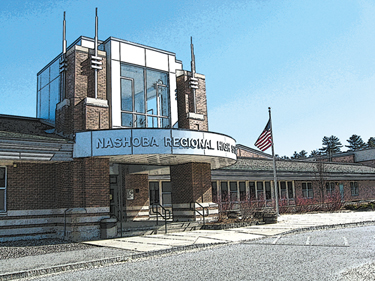
Clarification…
In last week’s School Committee article related to the integrated pre-school program changes, the article stated, “Legally, Nashoba must limit the number of role models…” To clarify, the ratios must be based on the regulations set forth by the Mass. Dept of Ed. The regulations (603 CMR 28.06(7). http://www.doe.mass.edu/lawsregs/603cmr28.html?section=06) state: “For public school programs that integrate children with and without disabilities, the class size shall not exceed 20 with one teacher and one aide and no more than five students with disabilities. If the number of students with disabilities is six or seven then the class size may not exceed 15 students with one teacher and one aide.”
Budget numbers and Pre-K at School Comm
By Ann Needle
The Nashoba School Committee heard public feedback at its Dec. 6 meeting, with residents in attendance commenting on recent changes to the district’s pre-kindergarten program. These sometimes tense moments were later followed by a look at next year’s budget numbers, along with an announcement regarding renewal of the Nashoba teachers’ contract.
During Citizens Comments at the start of the meeting, there were approximately 10 audience members primarily there to comment on upcoming changes to the integrated pre-K program. The program is intended to provide students with special needs a classroom setting that includes typical or “role model” students. Outlined at the Nov. 29 SC meeting, the changes will, among others, trim the number of slots for role model students by about half. Administration voiced its hope that the changes will allow Nashoba to tailor the overall program more closely to the students with special needs.
School Committee Chair Lorraine Romasco announced that although SC policy restricts citizen comments to agenda items and pre-K was not on the current agenda, she acknowledged it was a high concern for many parents, and she therefore would allow a limited number of comments.
Romasco explained that she was choosing the residents who would be called on to comment based on those who had not spoken before the SC in the past.
The three residents’ comments included questioning the move to cut tuition-paying role models [SPED students attend for free]; the loss of opportunities for more role models to develop empathy and appreciation of diversity in an integrated pre-school; and that Nashoba’s changes in the SPED-to-role-model ratio go against some government guidelines.
When the residents finished, a fourth audience member demanded to speak, and did not stop when Romasco rejected his request. Bolton Police were called in to handle the apparently agitated resident. The resident quietly left the room and the meeting resumed with no further issues.
According to a statement from Bolton Police Chief Warren Nelson, “The Bolton Police Department was contacted by Town Administrator Donald Lowe [who was in the audience] requesting police assistance at the School Committee meeting for an individual causing a disturbance. The meeting was put in recess by School Committee Chairperson Lorraine Romasco while they awaited the police arrival. At this time no charges are being put forward. We do not condone this type of behavior and hope that in the future matters like this can be handled in a more calm, reasonable manner. ”
Romasco assured that pre-K would be on the agenda for the SC’s Dec. 20 meeting. Noting the letters and emails the SC has received on the topic, Romasco reported that she has asked Superintendent Brooke Clenchy to prepare a document “to answer the common frustrations coming to us.” Meanwhile, Romasco urged concerned parents to also speak with their elementary school principals. “They’re the ones you need to talk to [and] ask them why they made the recommendations they did.”
Preliminary 2018/19 Budget
Brooke Clenchy strongly stressed that the preliminary glimpse of the 2018/19 budget about to be reviewed was just that. Still, it was a glimpse that mirrored some of what administration has been warning about concerning cuts in government grants to Nashoba.
Showing a one-page, tentative overview of the district’s main budget drivers for next fiscal year, Nashoba Interim Business Manager Pat Marone pinned the overall budget increase at almost 7 percent. Though not all of the information the district needs to form a final budget proposal is ready, Marone highlighted areas of note, including about a 7 percent increase in Existing Salaries, but a reduction of almost 3.8 percent in Insurance and Benefits. She also noted that the $369,000 increase in Facilities has accounted for an estimated $150,000 to fix the out-of-compliance septic system at Nashoba Regional High School.
Looking at potential revenue sources, Marone underscored expected reductions in the state’s “circuit breaker” funding of about $113,700; a drop of more than $279,000 in School Choice income, as 23 choice students from other communities graduate from the high school; and the loss of the SPED Program Improvement grant, worth almost $28,000. Asked about the Excess & Deficiency (free cash) account, Marone estimated this would be at about $1.7 million at the end of 2017, with a preliminary plan to reduce the appropriation to that fund.
In other budget-related news, Chair Romasco announced that the SC unanimously voted in Executive Session during Wednesday’s SC meeting to ratify the proposed Unit A (full-time teachers) contract. Saying she was “absolutely thrilled,” Romasco also remarked that the contract “represents a true respect for the teachers and staff in this district.” According to Brooke Clenchy’s office, the final contract will not be drafted for union signatures until the end of the month.
Earlier this year, Clenchy mentioned that any pay increase for Unit A could not be budgeted until the final contract was approved. Negotiations began on the contract back in the spring, and traditionally are finished by the start of the following school year.

